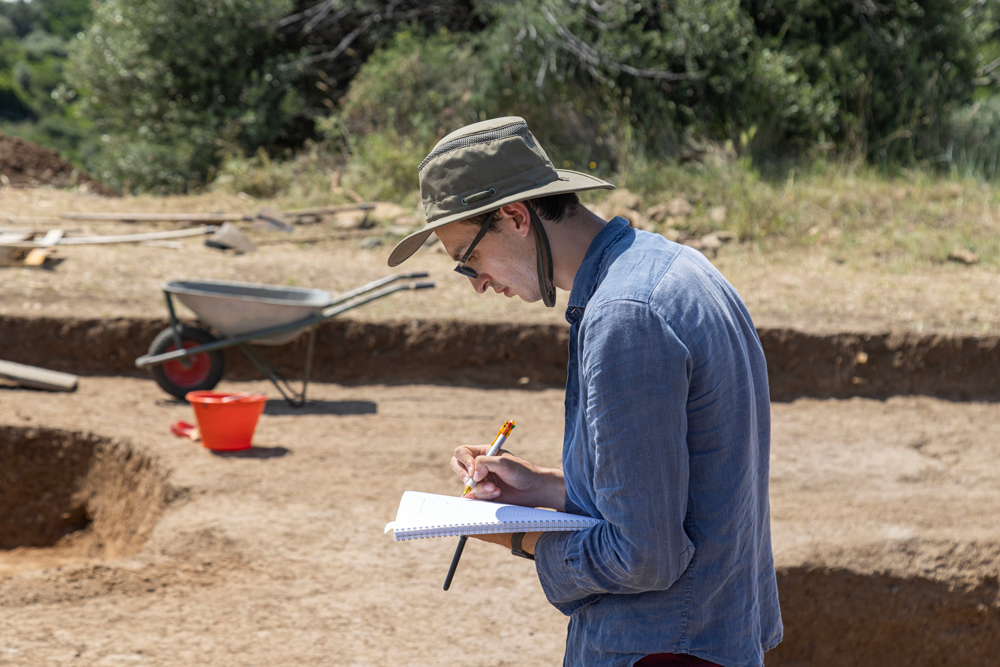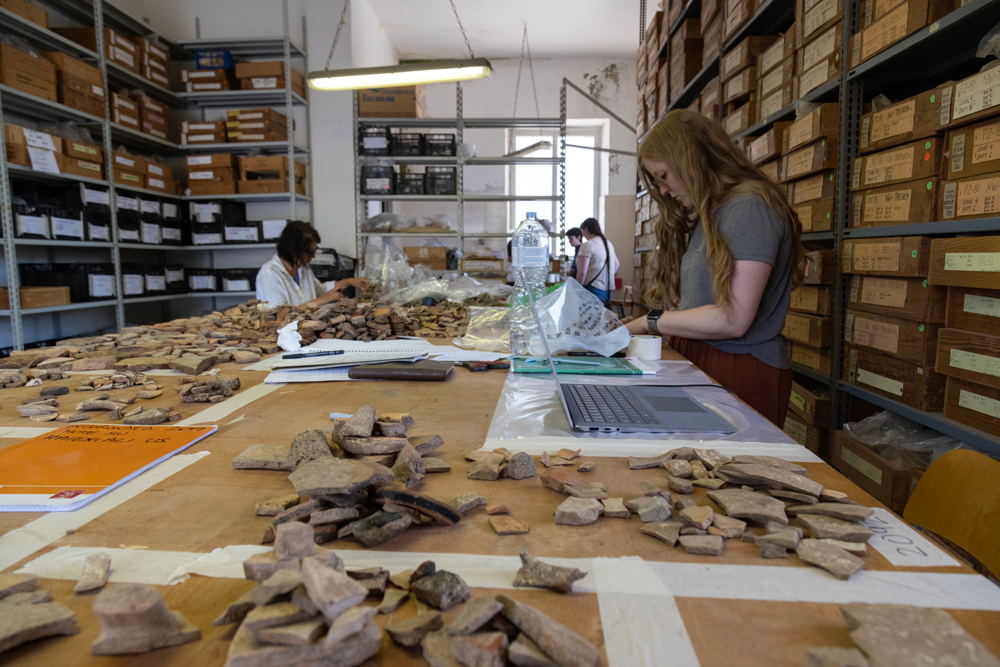
BY Written by Sara Laux. Photos and video by Colin Czerneda.
January 17, 2024
McMaster students set out to solve a puzzle 3,000 years in the making
The Metaponto Archaeological Project is not only bringing the history of ancient civilizations to light—it’s also training the next generation of archaeological leaders.
It’s another hot day in Basilicata, in southern Italy, but at least the sun’s out and the threat of rain at the Incoronata Greca archaeological site seems remote.
Part of the Metaponto Archaeological Project team, an ongoing collaboration between McMaster’s department of Greek and Roman Studies and St. Mary’s University (SMU) in Halifax, is working in an area of the site that seems to have a recessed floor.
There’s also a pit in it filled with snail shells. Many, many snail shells.
McMaster PhD candidate Eric del Fabbro is working with some of the SMU undergraduates and Italian archaeologist Felice Perciante to painstakingly extract each shell and add it to a Ziploc bag that will eventually hold more than 100 snail remains.
The team is working to reconstruct a picture of life almost 3,000 years ago, as the indigenous Oenotrian civilization came into contact with Greek settlers in the 8th century BCE.
It was a wave of colonization that would change the face of this part of Italy, as new people and new ideas swept through the territories of the existing tribes, eventually subsuming them beneath the more dominant Greek culture.
Learn more about the Metaponto Archaeology Project here

Indeed, the site itself feels almost like a sentient thing, and the work the team is doing is the payment for learning its stories.
“This spot is teasing us – every time we think we’re done and have found all we can find, it throws up something interesting,” says a wry Marshall Zuckerman, a master’s student in Greek and Roman studies at McMaster. “There are pits in pits! Thanks, Oenotrians.”
Zuckerman, who’s originally from Montreal, is new to the excavation this year, joining the three other grad students as an assistant dig director and de facto teaching assistant for the SMU undergrads – all learning the professional skills it takes to be both an archaeologist and a teacher.
And, of course, they’re all pursuing their own work, as dissertations take shape based on years of field study and other research.

For del Fabbro, participating in the Metaponto Archaeological Project between his undergraduate and master’s degree got him hooked on the material culture of the Oenotrians. He’s now researching black glaze pottery produced around Metaponto, and working on reconstructing the city’s expansion outside the city centre.
“We’ve found some pretty amazing pottery this year, both Oenotrian and Greek. I particularly liked a little Corinthian aryballos, which was a container for perfume. There’s also been some indigenous ceramics, including a very large container with cool handles that are functional but also very decorative,” he says.
“It’s tremendously exciting and kind of frightening when you unearth something – that’s why I’m here every day.”

The development of new digital technology is creating some interesting opportunities for research as well. Christine Davidson, a McMaster PhD candidate and Trent University lecturer, uses GIS (geographic information system) technology along with software to help lay out possible routes taken by ancient settlers. For example, if the geographic data shows steep cliffs and no water source, it’s less likely that settlers would go that way to find a new place to live. Flat topography and a nice flowing river? Likely a better route – technically known as a “least cost path” – and a better place for an archaeological survey.

The benefit of working on the Metaponto Archaeological Project as a grad student is that each of them is able to work with new material for their dissertations, rather than re-examining work done by other scholars, says Spencer Pope, a professor of Greek and Roman studies at McMaster and co-director of the Metaponto Archeological Project.
“With this excavation, we have new original archaeological data surfacing daily, and with that, research grows,” Pope says, as he watches the snail shells get extracted from their pit. “Their work doesn’t begin in the library, but with material we’ve collected and excavated. They have an opportunity to say something new or original and make a contribution to the field.”

Of course, it’s not just graduate students benefiting from the Metaponto Archaeological Project’s field experience. Undergrads, too, gain a unique understanding of what it means to be an archaeologist – and what it means to work in the discipline as it changes with the times.
“It’s important to bring students here so they can evaluate the complexity of the interactions of the ancient world and understand that it’s relevant and important to read Sophocles and Cicero, but there’s another level of understanding that comes through archaeological excavation and material culture,” explains Sveva Savelli, an associate professor of ancient studies and intercultural studies at St. Mary’s University, and the co-director of the Metaponto Archaeological Project.
“If we want to change our lens and start to understand the ancient world not only through ancient sources, material culture is our only answer. If we want to hear the voices of the populations who were not able to write, this is what we need to investigate.”

This year, seven undergraduate students from St. Mary’s University have joined the project in Italy for the first time. In other years, undergraduates from McMaster have participated as well.
“It’s been so exciting to try something new, and working on such a dynamic site,” says Zea Jones, an SMU undergrad who’s majoring in anthropology with a double minor in classics and religious studies. “The PhD students are fantastic teachers, and this is a great practical application of what I’ve learned. It’s an extra tool in my back pocket when I tackle theoretical work.”
While undergraduates get a lot of hands-on experience at the site and in the project’s lab, their experience isn’t just work. They’ve travelled around the area, exploring hill towns like Pisticci and Bernalda, nestled high above the valley and offering a glimpse into everyday life in a small Italian town.
They’ve also learned more about the history and the culture of the area – including touring the factory that makes Amaro Lucano, an herbal liqueur with a closely guarded secret recipe that has been produced in Pisticci since the late 19th century. (Unfortunately, the factory didn’t offer free samples.)
In the end, though, it really all comes down to the thrill of the find.
“It’s really fantastic as an undergrad to have this kind of experience, because hands-on fieldwork isn’t something that every undergrad gets to do,” says Joe Stewart, an SMU undergraduate student and research assistant who’s on his second year with the dig. “My first day here last season I was finding little tiny sherds of pottery, and it was the coolest thing ever.
“This can be tough work when you’re tired and feeling dehydrated – but it’s so exciting when you do find something that you just keep going.”
Want to learn more about the Metaponto Archaeology Project? Click here to explore the history of the project, learn more about the student experience and discover other archaeological initiatives in Italy.

